|
|
Home
|
COSMIC ENERGY AND VASTU
|
|
|
|
Register
|
|
Energy DynamicsVastushastra
essentially deals with two energy sources - the solar energy flux and
the geomagnetic energy flux. The science of vastu aims at controlling
the flow of these energies in a vastu by selecting proper directions and
alignments for the vastu. Location of doors, windows, color scheme, flooring
patterns, planting of trees - all these parameters play an important role in
enhancing energy field for human being to live in harmony with nature.The
south, southwest and the west are the directions subjected to excessive cosmic
particle activity.
Conventionally, the north
is source and the south is the sink for electromagnetic flux
lines. Sub atomic particles travelling along the geomagnetic flux lines end up
at the southern tip. Excessive cosmic radiation particles, particularly,
positively charged particles, enter the earth from the west rather than the
east.
|
|
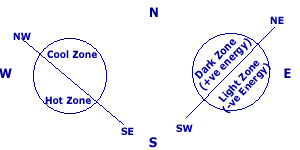
|
|
Specially,
in Indian context, excessive solar radiation come from south,
southwest, and southeast directions. It is always suggested that the compound
walls in the south direction should be greater in height and thikness. Also,
the plinth of all the rooms in the south should be more. It is suggested to
construct basements, underground water tanks and extra floor on the south side,
with terraces towards the north and east directions.
|
|
| Cosmic
Energy, Helix And Golden Ratio To
contain these vortices of cosmic and thermal imbalances, vastushastra offers a
remedy in the form of the helix concept. Helix , the natural growth
shape is known as the mystery and the magic of the almighty. It finds refrence
in all the ancient scriptures as the centre of energy balance is located at the
origin of a a logarithmic helix fitted in a rectangle with sides having
proportianate golden ratio of 1:1.618.
|
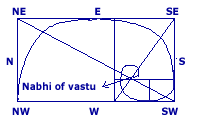 |
|
|
The
effects of most of the vastudosha diminish automatically if this helix centre
lies in side the vastu. The idea of constructng the vastu in the south west
zone implies arranging of the centre of energy balance in the actual
building area.This center is the nabhi or the focal point of the plot
and is the source of all cosmic energies. The centre is confined to the vastu
by constructing the vastu in the south west zone. Rather the vastu experts
should try to position this power in the north east zone of the vastu. Before
planning any vastu, the plot should be demarked in the ratio 1:1.618
(length:breadth) known as the golden ratio. A helix flowing from north east to
south west should be marked to fix the nabhi (energy centre) of the vastu. The
nabhi is treated as the brahamsthal (focal point) of the vastu and around this
focal point, equidistant borderlines should be drawn. With nabhi as vastu
centre, other rooms can be planned easily.
The two activities,
breathing of vastu and manifestation of energy, are centred around
nabhi. If the nabhi and brahamsthal of the vastu coincides, there is an
enhancement of the vital characteristics and virtues of the vastu. The flaws in
the vastu can be traced to and technically analysed on the basis of the
difference between the nabhi and the brahamsthal of the vastu.
If the north east,
north and east sides of the plot are provided with slopping terrain and then
the massiveness is increased systematically from south east to south west, with
a gradual rise towards the south west and slope towards the north east, then
the nabhi of such a plot acts as the centre of all energies emerging from the
interior of the earth and other cosmic energies. This results in the creation
of an envelope of life sustainig energy vibrations around the entire vastu.
Raising of the plinth
in the south direction, having a underground water tank or open water body in
the north, east or northeast direction and all such tenets of vastu planning as
explained before, help to achieve the golden ratio and implement the helix
concept in a house. A few predominant effects are -
1. Interrupting the
south pingala current flow.
2. Achieving energy-mass balance through, proportionate compensation for
geomagnetic and energy disturbances.
3. Augmenting the north idla current flow, bestowing the vastu with drive
bliss.
4. Regulating the excessive southern zone temperatures through water vapour
emission processes of trees like nilgiri and neem.
5. Creating healthy atmosphere in the house through the scent and aroma of
herbal plants.
6. Enhancing the quality of the vastu through beneficial effects of transverse polarisation
of sunlight falling on an open water surface.
|
|
The Importance Of ShapeEvery
shape in nature has definite role to play. Environmental circumstances and
conditions dictate shape, and other qualities of living and non living
entities. The helix or the spiral has been considered as a shape that is union
of right angle and a sphere. The right angle represents the existence,
a thought (purush) and the sphere represents the shadow of existence, a
sentiment (prakriti). The right angle with the spiral flow of energy
forms the sacred and growing shape.
The circle represents
a state of flux, the expanding energy from it's centre evolving it's shape,
ultimately culminating in the square.
Squares and rectangles
represent dynamically balanced figures and shapes. Squares and rectangles match
their axes with geo-magnetic axis. Force lines of gravitation and
magnetism do not form any zigzag pattern in square and rectangle. The flow of
elementary particles through such figures will hardly intersect the network of
force lines. This will lead to a healthy, good and salubrious cosmic
environment.
The most prefered
shape in the vastushastra is square as it does justice to all the eight
directions. The square symbolises order, stability, and the final state of
evolving life. It is perfection beyond life and death. The essence of the
square is retained by any mandala as long as the area is kept unaltered. It
embodies prithvai tatwa which in turn symbolises shabda (speech), sparsha
(touch), roop (shape), rasa (taste), and gandha (smell), the entities catalysts
of wordly pleasures.
Rectangles with
the minor axis along the east-west direction and major axis along the
north-south will have the least lateral perimeter exposure to the sun,
resulting in cooler and shadow sections, whereas in the reverse case where the
minor axis is along the north-south direction, a very large perimeter gets
exposed to the sun which is objectionable in vastushastra.
|
|

|
|
Any excessively high temperature characteristics create disturbance in magnetic
force lines, imparting them with random zigzag pathways leading to cosmic
hazards. Hence in old structures, thick walls are found on the south
side which has outstanding characteristics to resist radiation effects. |
|
Planning
Vastu In Plots Of Irregular Shape
The position of house
in a plot, the size and the shape of the house are of extreme importance for
attaining requisite virtues in a vastu through balancing of known and
unknown forces made possible by proper location of the vastu in a vastu kshetra.
A good balanced posture of a house in a plot bestowing divine bliss on the
household can be planned by giving due consideration to the effective influence
of each direction.
|
|
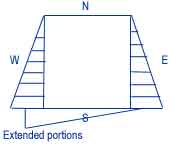 |
Extended
south direction means reduced stress concentration requiring reduced
matter content.
Elevate the south east and south west plinth sides.Construct additional floors
on the south east and south west sides simultaneously and add heavy
gravitational mass to the shaded direction. Additional length on the south side
and narrowing of the north side require the usual treatment of normal gravitational
mass on the south side and maximum open spaces on the north
side.Creating maximum terraces on the north zone is the basis of planning for
this case. |
|
|
| Due to
additional northeast and reduced south and southwest, there is excessive
stress concentration towards the south due to coagulation of magnetic
force lines from extended north region getting focus on a small width of south
region.
Creating basements
towards the north and noth east, with provision for higher and dense zones
towards the south, south west and south east sides. can reduce the vastudosha
in this case. Landscaping and plantation should also be considered to
minimise the stress on the south.
|
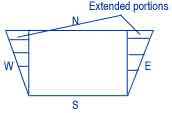 |
|
|
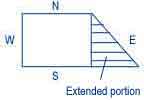 |
Extended
south implies reduced stress concentration, thereby allowing normal loading on
the south side. Load in the south east zone is to be increased by raising south
east plinth or adding extra floor in south east. Reduced north can be
compensated by construction of basement and placing some water source in the
north direction.
Availability of
excess southeast zone permits the building alignment to be shifted to
the south east corner to match the overall centre of construction with the shifted
centre of energy of the entire plot.
|
Aryabhatt software Vedic atrology
Western astrology Numerology
Chinese astrology K.P.
Astroterms Astro
gems Gemnology
Kundalini Astro and health
|
|
